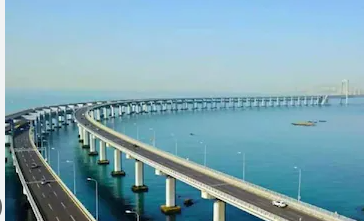
Manas Dasgupta
NEW DELHI, Jan 12: The Prime Minister Narendra Modi on Friday inaugurated India’s longest sea bridge Mumbai Trans Harbour Link (MTHL) officially named “Atal Setu Nhava Sheva Sea Link,” named after the former prime minister Atal Bihari Vajpayee, to shorten the travel time between Mumbai and Navi Mumbai from the present 90 to 120 minutes to just about 20 minutes.
The 21.8 kilometre long six-lane bridge, constructed at a cost of over Rs 17,840 Crores, include about 16.5 kms built on the sea and viaducts on land at either end with a cumulative length of 5.5 km. The bridge that was first conceptualised six decades ago will cut the travel time between Sewri in Mumbai and Chirle in Raigad district to under 20 minutes.
The objective of the project is to improve connectivity in the Mumbai Metropolitan Region which comprises the districts of Mumbai, Thane, Palghar, and Raigad, and promote the region’s economic development. The MTHL will bring Mumbai and Navi Mumbai closer by dramatically cutting travel time, and will decongest the existing route over the Vashi bridge.
Officials said apart from bringing Mumbai and Navi Mumbai closer, the Atal Setu would help ease traffic and enhance transportation, and also serve as an engine of economic growth. The MTHL will provide faster connectivity to the Mumbai International Airport and the Navi Mumbai International Airport and also reduce travel time from Mumbai to Pune, Goa and South India and boost connectivity between the Mumbai Port and the Jawaharlal Nehru Port.
The Atal Setu is India’s first sea bridge to implement an open road tolling system, which will allow vehicles to pass through toll booths at speeds of up to 100 kilometres per hour without having to stop.
IIT Bombay had been roped in to strengthen the Atal Setu during its construction in 2018, and a team worked to ensure the design was done keeping in mind that it falls under a moderate earthquake damage risk zone. Professor Deepankar Choudhury, Head of Civil Engineering at IIT Bombay, said the bridge was built to withstand four different types of earthquakes of up to 6.5 magnitude. The lights used on the bridge were also chosen carefully to ensure that they do not disturb the aquatic environment.
“This is India’s longest bridge built on the sea. Several technologies have been used in the making of this bridge, which are used for the first time in India. The lights used in this bridge do not disturb the aquatic environment,” Dr Sanjay Mukherjee, Commissioner of Mumbai Metropolitan Region Development Authority, said.
To be opened for public on Saturday with speed limit of 100 kms per hour, the toll on the bridge for cars will be ₹ 250 for a single journey and ₹ 375 for a return journey, which has been criticised by opposition parties as being too high. Officials, however, pointed to fuel savings, saying that would be ₹ 500 per journey. Two wheelers, auto-rickshaws, tractors, animal-driven carriages and other slow-moving vehicles would not be allowed on the “Atal Setu.”
In December 2016, Mr Modi had laid the foundation stone of the bridge marking the historic milestone in India’s infrastructure development. The idea of a bay crossing connecting Mumbai to the mainland was first floated in 1963 by the American construction consultancy firm Wilbur Smith Associates, but no follow-up action was initiated. The plan was revived in the late 90s, and the first tenders were floated in 2006.
In February 2008, Anil Ambani’s Reliance Infrastructure emerged as the preferred bidder after promising to build and recover the cost of building the (then) Rs 6,000 crore bridge in nine years and 11 months through a public private partnership (PPP) model.
Months later, however, Ambani withdrew from the project. Multiple unsuccessful bidding processes followed, and the nodal agency was changed from the Maharashtra State Road Development Corporation (MSRDC) to the Mumbai Metropolitan Region Development Authority (MMRDA).
The project finally got moving after MMRDA entered into an agreement with Japan International Cooperation Agency (JICA), which agreed to fund 80 per cent of the project cost, with the rest being borne by the state and central governments.
The deal and tendering were finally completed in December 2017, and work commenced in early 2018. A total Rs 21,200 crore has been spent on the project, of which Rs 15,100 is loan from JICA. Close to 40,000 vehicles are expected to use the link every day in the opening year (2024).
The project is expected to facilitate greater economic integration of Navi Mumbai with Mumbai, with benefits extending to Panvel, Alibaug, Pune and Goa. It will very significantly improve connectivity between South Mumbai and the under-construction Navi Mumbai International Airport, the Mumbai Pune Expressway, the Mumbai-Goa Highway, and the main hinterland in general. It will also provide improved access to Jawaharlal Nehru Port.
While the project has obvious benefits in terms of furthering the development and prosperity of the megapolis and its extended neighbourhood, there are doubts on whether it will be of any help to regular commuters who travel between Mumbai and Navi Mumbai every day.
The Rs 250 toll for a one-way crossing of the Trans Harbour Link is deemed to be high, and the landing points of the bridge on the mainland side — Shivaji Nagar in Ulwe, and Chirle — are more than 10 km away from the main residential areas of Vashi, Nerul, Sanpada, Juinagar, and Seawoods, which will add to the commuting cost.
No public transport facilities, such as buses on a dedicated lane, have been announced on the bridge yet.













